Leadership and Management Analysis: ASDA's Operational Strategies
VerifiedAdded on 2020/06/06
|17
|5308
|42
Report
AI Summary
This report provides a comprehensive analysis of leadership and management practices within ASDA, a British supermarket retailer. It begins by defining the distinct roles and characteristics of leaders and managers, emphasizing their importance in achieving organizational goals. The report then delves into the roles of leaders and functions of managers in various situational contexts, highlighting the adaptability required in dynamic business environments. It also explores different leadership theories, such as system leadership and situational leadership, and their application within ASDA. Furthermore, the report examines the key approaches and significance of operations management, detailing factors that can impact operational effectiveness. The report is structured into four tasks, covering leadership and management roles, situational contexts, leadership theories and operational management. The report also provides insights into how ASDA can improve its operational strategies for better outcomes.
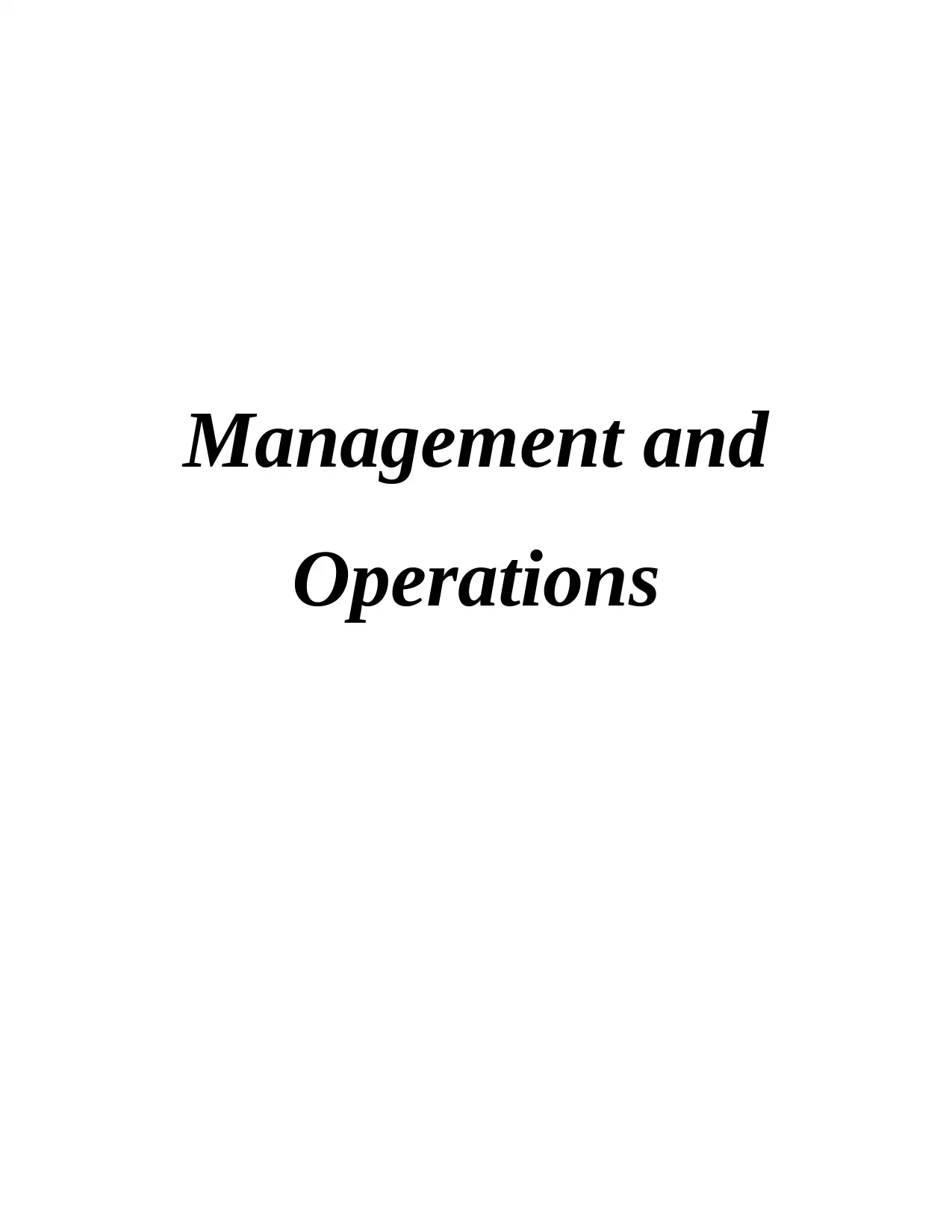
Management and
Operations
Operations
Paraphrase This Document
Need a fresh take? Get an instant paraphrase of this document with our AI Paraphraser
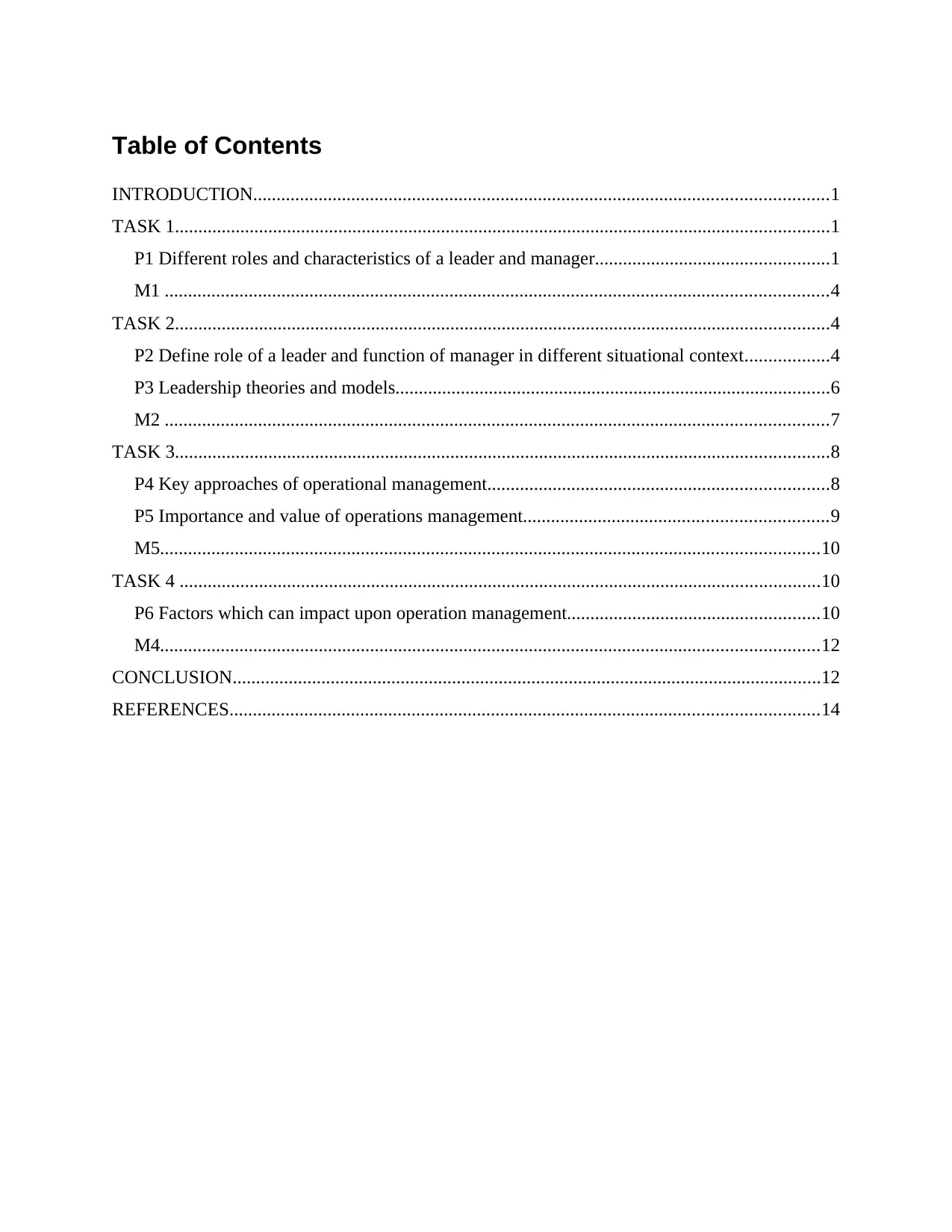
Table of Contents
INTRODUCTION...........................................................................................................................1
TASK 1............................................................................................................................................1
P1 Different roles and characteristics of a leader and manager..................................................1
M1 ..............................................................................................................................................4
TASK 2............................................................................................................................................4
P2 Define role of a leader and function of manager in different situational context..................4
P3 Leadership theories and models.............................................................................................6
M2 ..............................................................................................................................................7
TASK 3............................................................................................................................................8
P4 Key approaches of operational management.........................................................................8
P5 Importance and value of operations management.................................................................9
M5.............................................................................................................................................10
TASK 4 .........................................................................................................................................10
P6 Factors which can impact upon operation management......................................................10
M4.............................................................................................................................................12
CONCLUSION..............................................................................................................................12
REFERENCES..............................................................................................................................14
INTRODUCTION...........................................................................................................................1
TASK 1............................................................................................................................................1
P1 Different roles and characteristics of a leader and manager..................................................1
M1 ..............................................................................................................................................4
TASK 2............................................................................................................................................4
P2 Define role of a leader and function of manager in different situational context..................4
P3 Leadership theories and models.............................................................................................6
M2 ..............................................................................................................................................7
TASK 3............................................................................................................................................8
P4 Key approaches of operational management.........................................................................8
P5 Importance and value of operations management.................................................................9
M5.............................................................................................................................................10
TASK 4 .........................................................................................................................................10
P6 Factors which can impact upon operation management......................................................10
M4.............................................................................................................................................12
CONCLUSION..............................................................................................................................12
REFERENCES..............................................................................................................................14
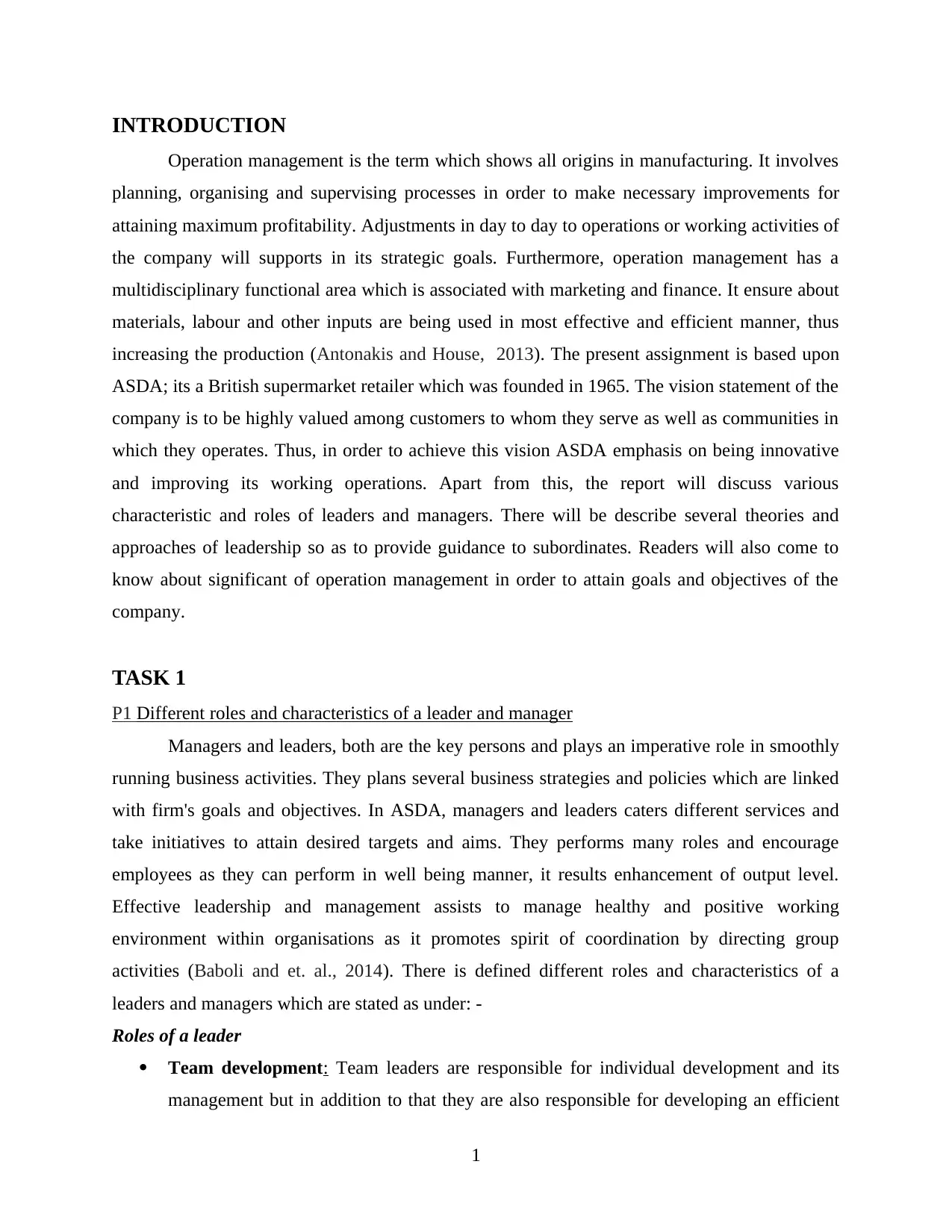
INTRODUCTION
Operation management is the term which shows all origins in manufacturing. It involves
planning, organising and supervising processes in order to make necessary improvements for
attaining maximum profitability. Adjustments in day to day to operations or working activities of
the company will supports in its strategic goals. Furthermore, operation management has a
multidisciplinary functional area which is associated with marketing and finance. It ensure about
materials, labour and other inputs are being used in most effective and efficient manner, thus
increasing the production (Antonakis and House, 2013). The present assignment is based upon
ASDA; its a British supermarket retailer which was founded in 1965. The vision statement of the
company is to be highly valued among customers to whom they serve as well as communities in
which they operates. Thus, in order to achieve this vision ASDA emphasis on being innovative
and improving its working operations. Apart from this, the report will discuss various
characteristic and roles of leaders and managers. There will be describe several theories and
approaches of leadership so as to provide guidance to subordinates. Readers will also come to
know about significant of operation management in order to attain goals and objectives of the
company.
TASK 1
P1 Different roles and characteristics of a leader and manager
Managers and leaders, both are the key persons and plays an imperative role in smoothly
running business activities. They plans several business strategies and policies which are linked
with firm's goals and objectives. In ASDA, managers and leaders caters different services and
take initiatives to attain desired targets and aims. They performs many roles and encourage
employees as they can perform in well being manner, it results enhancement of output level.
Effective leadership and management assists to manage healthy and positive working
environment within organisations as it promotes spirit of coordination by directing group
activities (Baboli and et. al., 2014). There is defined different roles and characteristics of a
leaders and managers which are stated as under: -
Roles of a leader
Team development: Team leaders are responsible for individual development and its
management but in addition to that they are also responsible for developing an efficient
1
Operation management is the term which shows all origins in manufacturing. It involves
planning, organising and supervising processes in order to make necessary improvements for
attaining maximum profitability. Adjustments in day to day to operations or working activities of
the company will supports in its strategic goals. Furthermore, operation management has a
multidisciplinary functional area which is associated with marketing and finance. It ensure about
materials, labour and other inputs are being used in most effective and efficient manner, thus
increasing the production (Antonakis and House, 2013). The present assignment is based upon
ASDA; its a British supermarket retailer which was founded in 1965. The vision statement of the
company is to be highly valued among customers to whom they serve as well as communities in
which they operates. Thus, in order to achieve this vision ASDA emphasis on being innovative
and improving its working operations. Apart from this, the report will discuss various
characteristic and roles of leaders and managers. There will be describe several theories and
approaches of leadership so as to provide guidance to subordinates. Readers will also come to
know about significant of operation management in order to attain goals and objectives of the
company.
TASK 1
P1 Different roles and characteristics of a leader and manager
Managers and leaders, both are the key persons and plays an imperative role in smoothly
running business activities. They plans several business strategies and policies which are linked
with firm's goals and objectives. In ASDA, managers and leaders caters different services and
take initiatives to attain desired targets and aims. They performs many roles and encourage
employees as they can perform in well being manner, it results enhancement of output level.
Effective leadership and management assists to manage healthy and positive working
environment within organisations as it promotes spirit of coordination by directing group
activities (Baboli and et. al., 2014). There is defined different roles and characteristics of a
leaders and managers which are stated as under: -
Roles of a leader
Team development: Team leaders are responsible for individual development and its
management but in addition to that they are also responsible for developing an efficient
1
⊘ This is a preview!⊘
Do you want full access?
Subscribe today to unlock all pages.

Trusted by 1+ million students worldwide
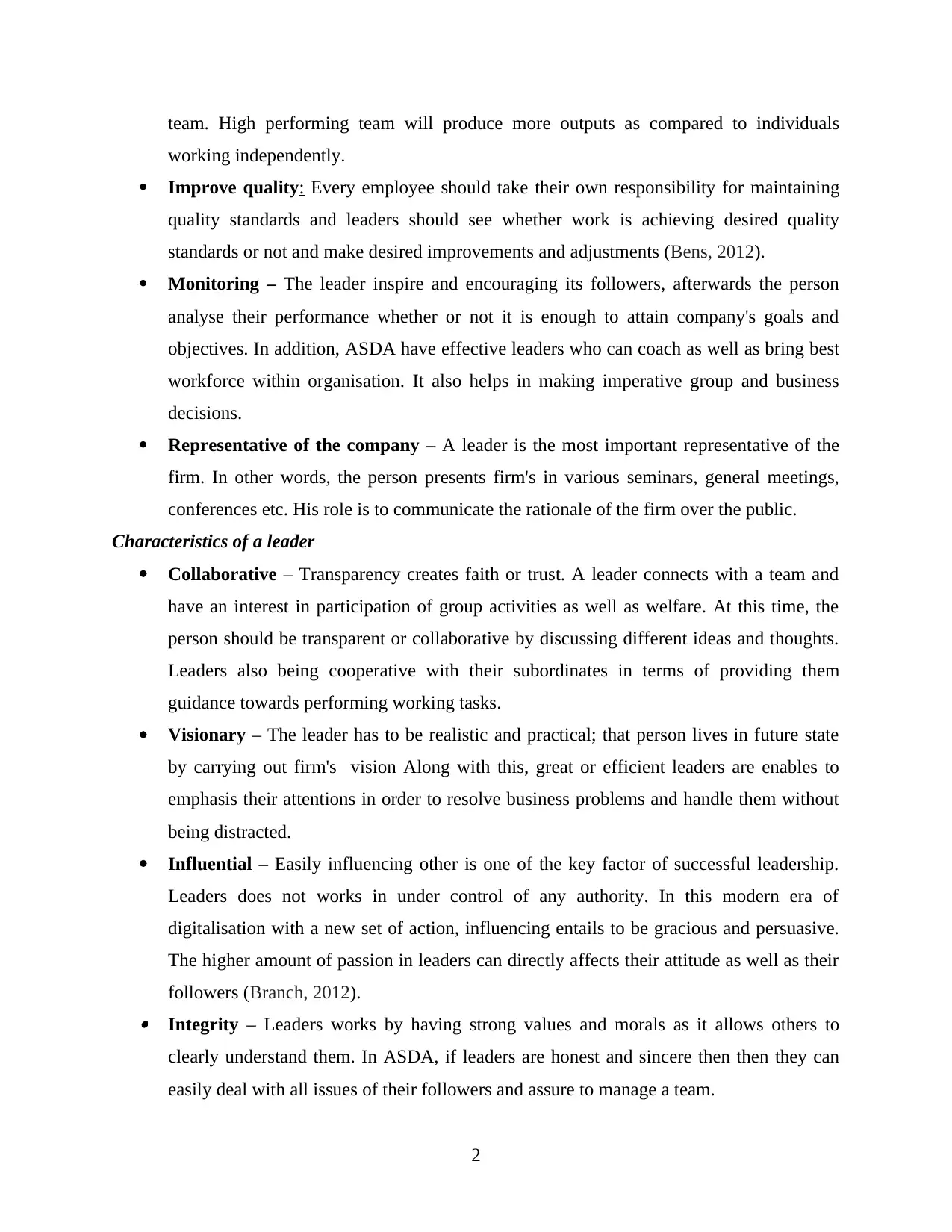
team. High performing team will produce more outputs as compared to individuals
working independently.
Improve quality: Every employee should take their own responsibility for maintaining
quality standards and leaders should see whether work is achieving desired quality
standards or not and make desired improvements and adjustments (Bens, 2012).
Monitoring – The leader inspire and encouraging its followers, afterwards the person
analyse their performance whether or not it is enough to attain company's goals and
objectives. In addition, ASDA have effective leaders who can coach as well as bring best
workforce within organisation. It also helps in making imperative group and business
decisions.
Representative of the company – A leader is the most important representative of the
firm. In other words, the person presents firm's in various seminars, general meetings,
conferences etc. His role is to communicate the rationale of the firm over the public.
Characteristics of a leader
Collaborative – Transparency creates faith or trust. A leader connects with a team and
have an interest in participation of group activities as well as welfare. At this time, the
person should be transparent or collaborative by discussing different ideas and thoughts.
Leaders also being cooperative with their subordinates in terms of providing them
guidance towards performing working tasks.
Visionary – The leader has to be realistic and practical; that person lives in future state
by carrying out firm's vision Along with this, great or efficient leaders are enables to
emphasis their attentions in order to resolve business problems and handle them without
being distracted.
Influential – Easily influencing other is one of the key factor of successful leadership.
Leaders does not works in under control of any authority. In this modern era of
digitalisation with a new set of action, influencing entails to be gracious and persuasive.
The higher amount of passion in leaders can directly affects their attitude as well as their
followers (Branch, 2012). Integrity – Leaders works by having strong values and morals as it allows others to
clearly understand them. In ASDA, if leaders are honest and sincere then then they can
easily deal with all issues of their followers and assure to manage a team.
2
working independently.
Improve quality: Every employee should take their own responsibility for maintaining
quality standards and leaders should see whether work is achieving desired quality
standards or not and make desired improvements and adjustments (Bens, 2012).
Monitoring – The leader inspire and encouraging its followers, afterwards the person
analyse their performance whether or not it is enough to attain company's goals and
objectives. In addition, ASDA have effective leaders who can coach as well as bring best
workforce within organisation. It also helps in making imperative group and business
decisions.
Representative of the company – A leader is the most important representative of the
firm. In other words, the person presents firm's in various seminars, general meetings,
conferences etc. His role is to communicate the rationale of the firm over the public.
Characteristics of a leader
Collaborative – Transparency creates faith or trust. A leader connects with a team and
have an interest in participation of group activities as well as welfare. At this time, the
person should be transparent or collaborative by discussing different ideas and thoughts.
Leaders also being cooperative with their subordinates in terms of providing them
guidance towards performing working tasks.
Visionary – The leader has to be realistic and practical; that person lives in future state
by carrying out firm's vision Along with this, great or efficient leaders are enables to
emphasis their attentions in order to resolve business problems and handle them without
being distracted.
Influential – Easily influencing other is one of the key factor of successful leadership.
Leaders does not works in under control of any authority. In this modern era of
digitalisation with a new set of action, influencing entails to be gracious and persuasive.
The higher amount of passion in leaders can directly affects their attitude as well as their
followers (Branch, 2012). Integrity – Leaders works by having strong values and morals as it allows others to
clearly understand them. In ASDA, if leaders are honest and sincere then then they can
easily deal with all issues of their followers and assure to manage a team.
2
Paraphrase This Document
Need a fresh take? Get an instant paraphrase of this document with our AI Paraphraser
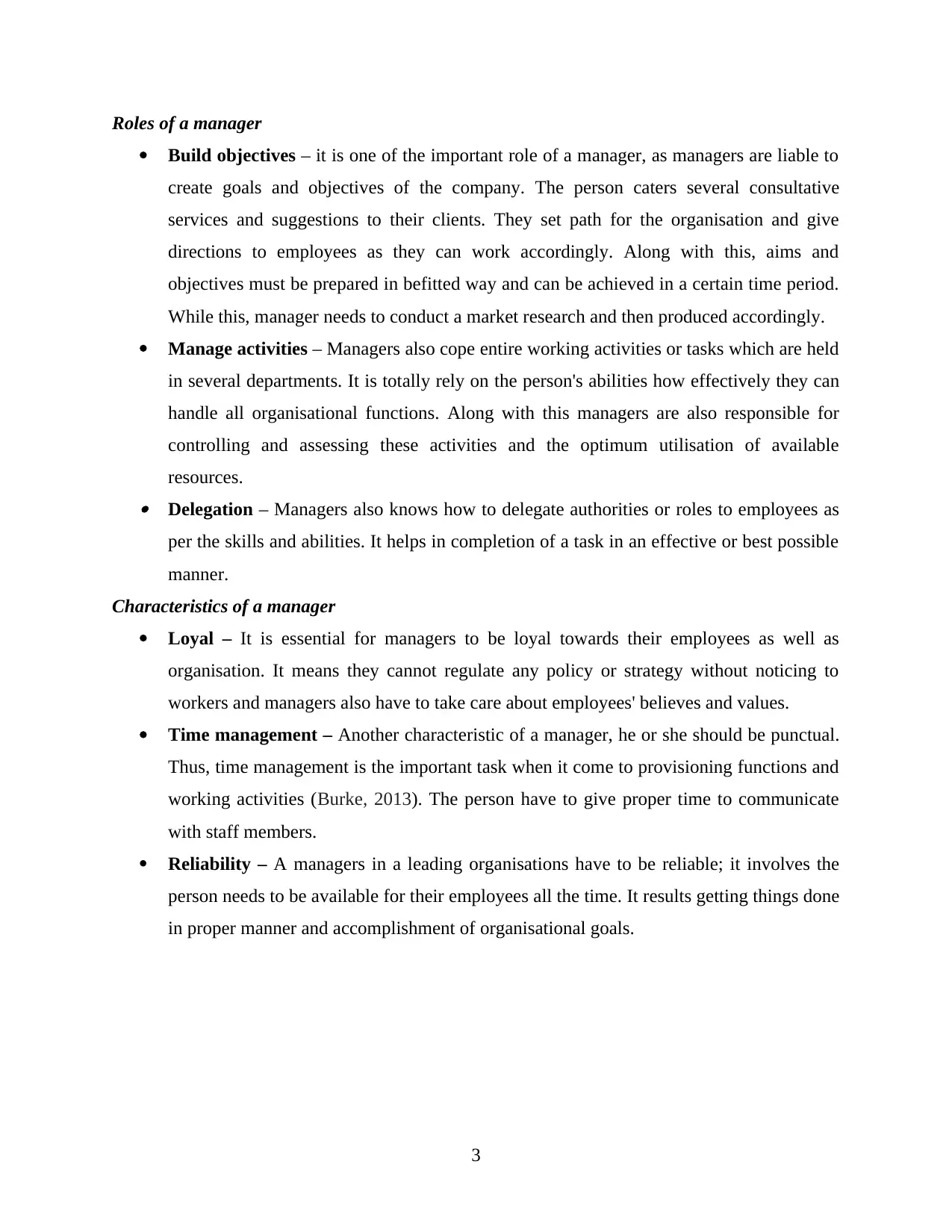
Roles of a manager
Build objectives – it is one of the important role of a manager, as managers are liable to
create goals and objectives of the company. The person caters several consultative
services and suggestions to their clients. They set path for the organisation and give
directions to employees as they can work accordingly. Along with this, aims and
objectives must be prepared in befitted way and can be achieved in a certain time period.
While this, manager needs to conduct a market research and then produced accordingly.
Manage activities – Managers also cope entire working activities or tasks which are held
in several departments. It is totally rely on the person's abilities how effectively they can
handle all organisational functions. Along with this managers are also responsible for
controlling and assessing these activities and the optimum utilisation of available
resources. Delegation – Managers also knows how to delegate authorities or roles to employees as
per the skills and abilities. It helps in completion of a task in an effective or best possible
manner.
Characteristics of a manager
Loyal – It is essential for managers to be loyal towards their employees as well as
organisation. It means they cannot regulate any policy or strategy without noticing to
workers and managers also have to take care about employees' believes and values.
Time management – Another characteristic of a manager, he or she should be punctual.
Thus, time management is the important task when it come to provisioning functions and
working activities (Burke, 2013). The person have to give proper time to communicate
with staff members.
Reliability – A managers in a leading organisations have to be reliable; it involves the
person needs to be available for their employees all the time. It results getting things done
in proper manner and accomplishment of organisational goals.
3
Build objectives – it is one of the important role of a manager, as managers are liable to
create goals and objectives of the company. The person caters several consultative
services and suggestions to their clients. They set path for the organisation and give
directions to employees as they can work accordingly. Along with this, aims and
objectives must be prepared in befitted way and can be achieved in a certain time period.
While this, manager needs to conduct a market research and then produced accordingly.
Manage activities – Managers also cope entire working activities or tasks which are held
in several departments. It is totally rely on the person's abilities how effectively they can
handle all organisational functions. Along with this managers are also responsible for
controlling and assessing these activities and the optimum utilisation of available
resources. Delegation – Managers also knows how to delegate authorities or roles to employees as
per the skills and abilities. It helps in completion of a task in an effective or best possible
manner.
Characteristics of a manager
Loyal – It is essential for managers to be loyal towards their employees as well as
organisation. It means they cannot regulate any policy or strategy without noticing to
workers and managers also have to take care about employees' believes and values.
Time management – Another characteristic of a manager, he or she should be punctual.
Thus, time management is the important task when it come to provisioning functions and
working activities (Burke, 2013). The person have to give proper time to communicate
with staff members.
Reliability – A managers in a leading organisations have to be reliable; it involves the
person needs to be available for their employees all the time. It results getting things done
in proper manner and accomplishment of organisational goals.
3
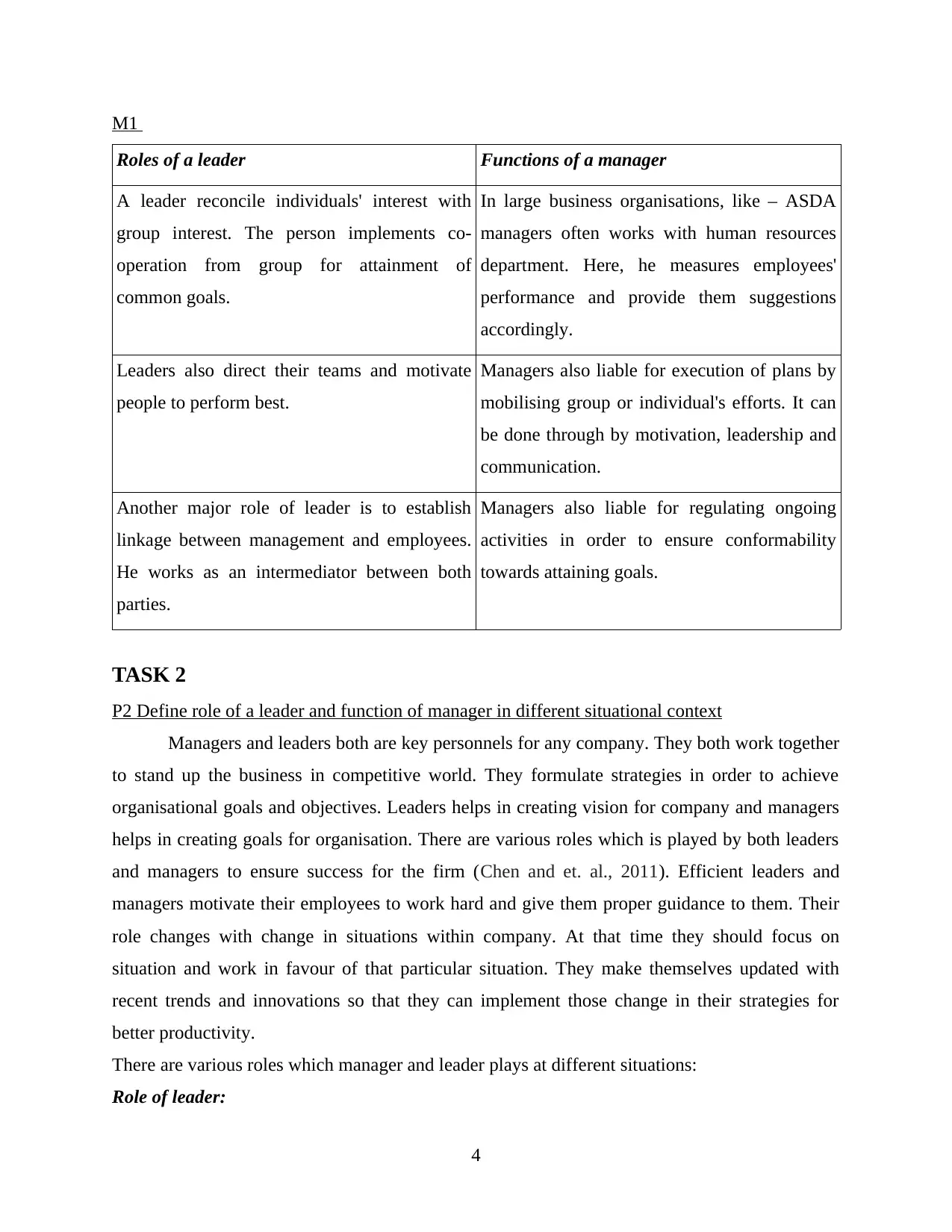
M1
Roles of a leader Functions of a manager
A leader reconcile individuals' interest with
group interest. The person implements co-
operation from group for attainment of
common goals.
In large business organisations, like – ASDA
managers often works with human resources
department. Here, he measures employees'
performance and provide them suggestions
accordingly.
Leaders also direct their teams and motivate
people to perform best.
Managers also liable for execution of plans by
mobilising group or individual's efforts. It can
be done through by motivation, leadership and
communication.
Another major role of leader is to establish
linkage between management and employees.
He works as an intermediator between both
parties.
Managers also liable for regulating ongoing
activities in order to ensure conformability
towards attaining goals.
TASK 2
P2 Define role of a leader and function of manager in different situational context
Managers and leaders both are key personnels for any company. They both work together
to stand up the business in competitive world. They formulate strategies in order to achieve
organisational goals and objectives. Leaders helps in creating vision for company and managers
helps in creating goals for organisation. There are various roles which is played by both leaders
and managers to ensure success for the firm (Chen and et. al., 2011). Efficient leaders and
managers motivate their employees to work hard and give them proper guidance to them. Their
role changes with change in situations within company. At that time they should focus on
situation and work in favour of that particular situation. They make themselves updated with
recent trends and innovations so that they can implement those change in their strategies for
better productivity.
There are various roles which manager and leader plays at different situations:
Role of leader:
4
Roles of a leader Functions of a manager
A leader reconcile individuals' interest with
group interest. The person implements co-
operation from group for attainment of
common goals.
In large business organisations, like – ASDA
managers often works with human resources
department. Here, he measures employees'
performance and provide them suggestions
accordingly.
Leaders also direct their teams and motivate
people to perform best.
Managers also liable for execution of plans by
mobilising group or individual's efforts. It can
be done through by motivation, leadership and
communication.
Another major role of leader is to establish
linkage between management and employees.
He works as an intermediator between both
parties.
Managers also liable for regulating ongoing
activities in order to ensure conformability
towards attaining goals.
TASK 2
P2 Define role of a leader and function of manager in different situational context
Managers and leaders both are key personnels for any company. They both work together
to stand up the business in competitive world. They formulate strategies in order to achieve
organisational goals and objectives. Leaders helps in creating vision for company and managers
helps in creating goals for organisation. There are various roles which is played by both leaders
and managers to ensure success for the firm (Chen and et. al., 2011). Efficient leaders and
managers motivate their employees to work hard and give them proper guidance to them. Their
role changes with change in situations within company. At that time they should focus on
situation and work in favour of that particular situation. They make themselves updated with
recent trends and innovations so that they can implement those change in their strategies for
better productivity.
There are various roles which manager and leader plays at different situations:
Role of leader:
4
⊘ This is a preview!⊘
Do you want full access?
Subscribe today to unlock all pages.

Trusted by 1+ million students worldwide
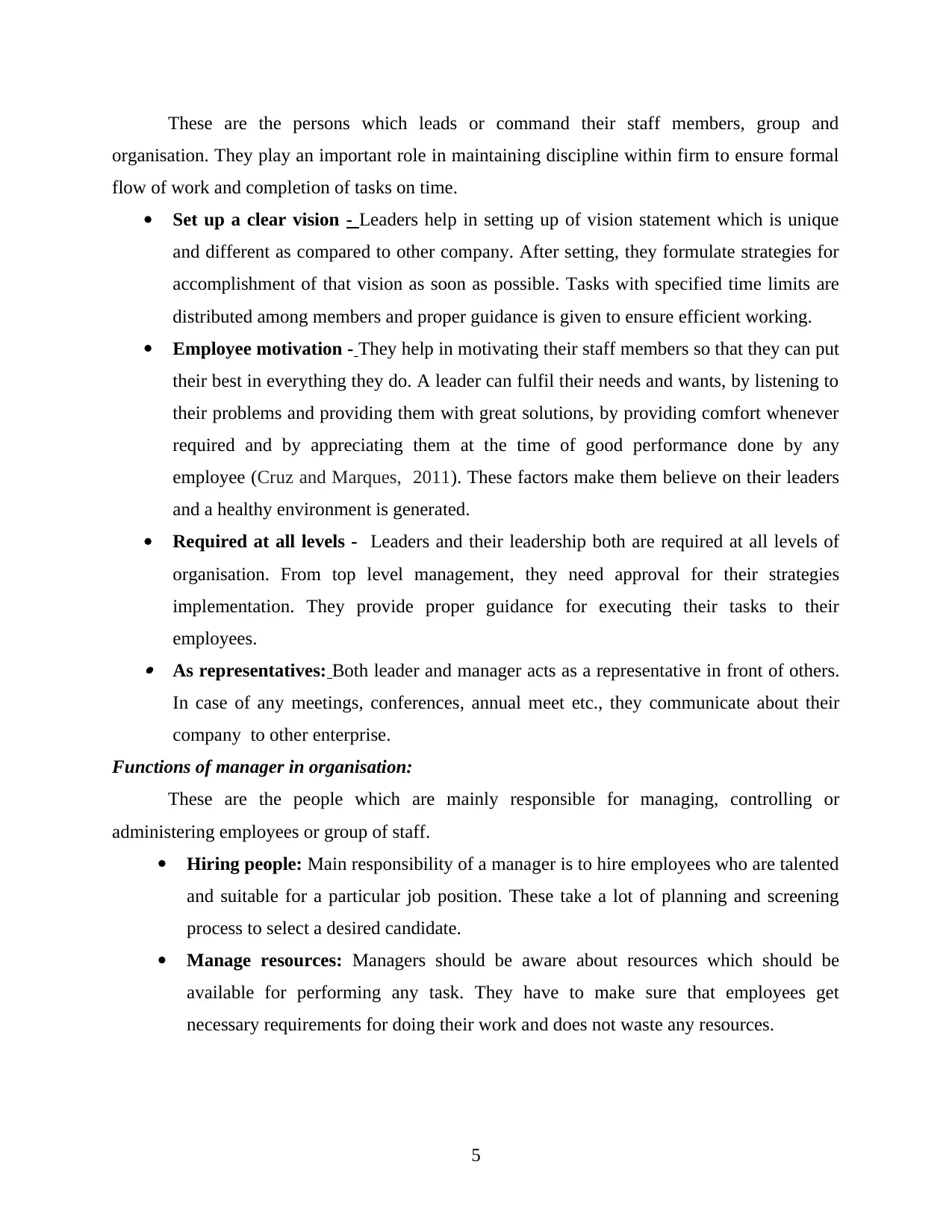
These are the persons which leads or command their staff members, group and
organisation. They play an important role in maintaining discipline within firm to ensure formal
flow of work and completion of tasks on time.
Set up a clear vision - Leaders help in setting up of vision statement which is unique
and different as compared to other company. After setting, they formulate strategies for
accomplishment of that vision as soon as possible. Tasks with specified time limits are
distributed among members and proper guidance is given to ensure efficient working.
Employee motivation - They help in motivating their staff members so that they can put
their best in everything they do. A leader can fulfil their needs and wants, by listening to
their problems and providing them with great solutions, by providing comfort whenever
required and by appreciating them at the time of good performance done by any
employee (Cruz and Marques, 2011). These factors make them believe on their leaders
and a healthy environment is generated.
Required at all levels - Leaders and their leadership both are required at all levels of
organisation. From top level management, they need approval for their strategies
implementation. They provide proper guidance for executing their tasks to their
employees. As representatives: Both leader and manager acts as a representative in front of others.
In case of any meetings, conferences, annual meet etc., they communicate about their
company to other enterprise.
Functions of manager in organisation:
These are the people which are mainly responsible for managing, controlling or
administering employees or group of staff.
Hiring people: Main responsibility of a manager is to hire employees who are talented
and suitable for a particular job position. These take a lot of planning and screening
process to select a desired candidate.
Manage resources: Managers should be aware about resources which should be
available for performing any task. They have to make sure that employees get
necessary requirements for doing their work and does not waste any resources.
5
organisation. They play an important role in maintaining discipline within firm to ensure formal
flow of work and completion of tasks on time.
Set up a clear vision - Leaders help in setting up of vision statement which is unique
and different as compared to other company. After setting, they formulate strategies for
accomplishment of that vision as soon as possible. Tasks with specified time limits are
distributed among members and proper guidance is given to ensure efficient working.
Employee motivation - They help in motivating their staff members so that they can put
their best in everything they do. A leader can fulfil their needs and wants, by listening to
their problems and providing them with great solutions, by providing comfort whenever
required and by appreciating them at the time of good performance done by any
employee (Cruz and Marques, 2011). These factors make them believe on their leaders
and a healthy environment is generated.
Required at all levels - Leaders and their leadership both are required at all levels of
organisation. From top level management, they need approval for their strategies
implementation. They provide proper guidance for executing their tasks to their
employees. As representatives: Both leader and manager acts as a representative in front of others.
In case of any meetings, conferences, annual meet etc., they communicate about their
company to other enterprise.
Functions of manager in organisation:
These are the people which are mainly responsible for managing, controlling or
administering employees or group of staff.
Hiring people: Main responsibility of a manager is to hire employees who are talented
and suitable for a particular job position. These take a lot of planning and screening
process to select a desired candidate.
Manage resources: Managers should be aware about resources which should be
available for performing any task. They have to make sure that employees get
necessary requirements for doing their work and does not waste any resources.
5
Paraphrase This Document
Need a fresh take? Get an instant paraphrase of this document with our AI Paraphraser
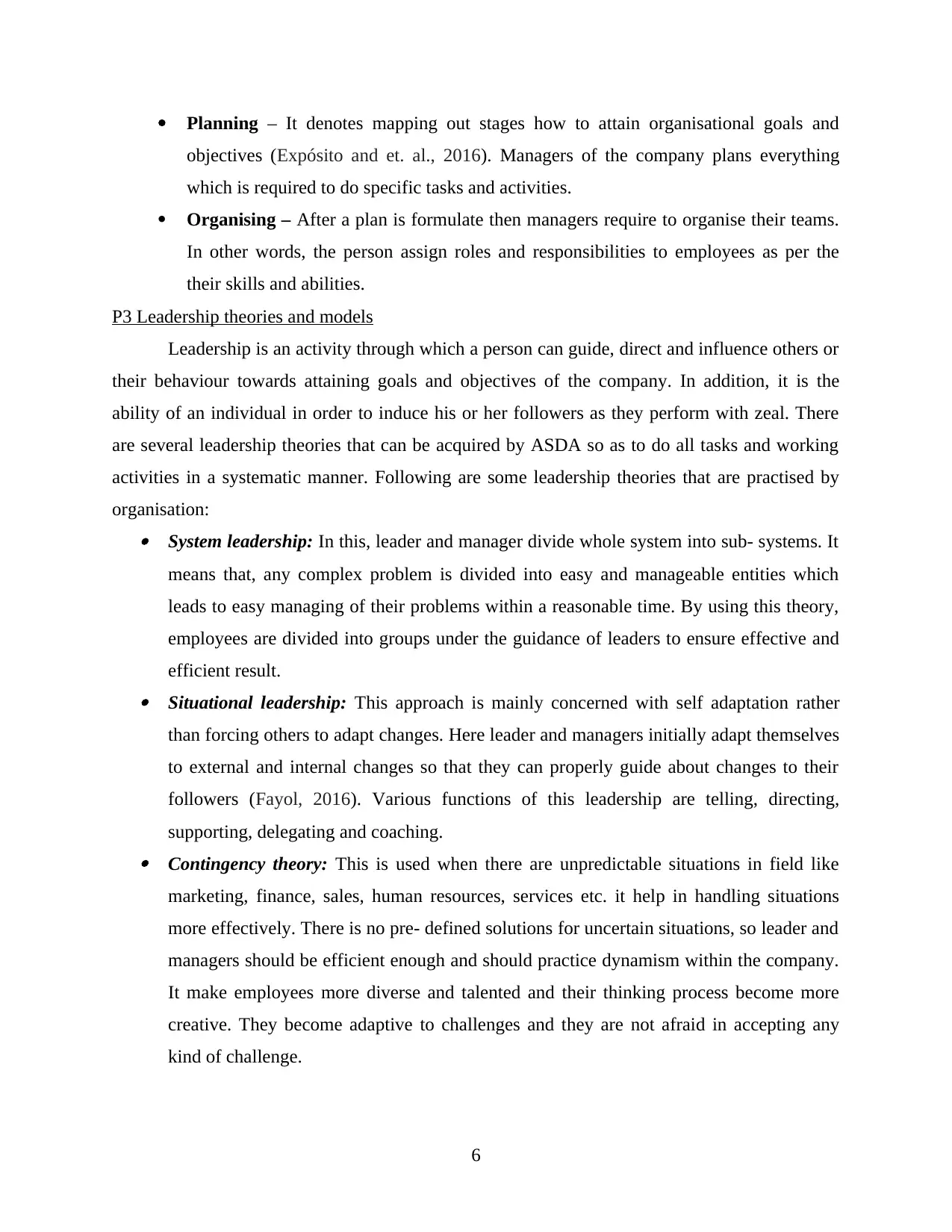
Planning – It denotes mapping out stages how to attain organisational goals and
objectives (Expósito and et. al., 2016). Managers of the company plans everything
which is required to do specific tasks and activities.
Organising – After a plan is formulate then managers require to organise their teams.
In other words, the person assign roles and responsibilities to employees as per the
their skills and abilities.
P3 Leadership theories and models
Leadership is an activity through which a person can guide, direct and influence others or
their behaviour towards attaining goals and objectives of the company. In addition, it is the
ability of an individual in order to induce his or her followers as they perform with zeal. There
are several leadership theories that can be acquired by ASDA so as to do all tasks and working
activities in a systematic manner. Following are some leadership theories that are practised by
organisation: System leadership: In this, leader and manager divide whole system into sub- systems. It
means that, any complex problem is divided into easy and manageable entities which
leads to easy managing of their problems within a reasonable time. By using this theory,
employees are divided into groups under the guidance of leaders to ensure effective and
efficient result. Situational leadership: This approach is mainly concerned with self adaptation rather
than forcing others to adapt changes. Here leader and managers initially adapt themselves
to external and internal changes so that they can properly guide about changes to their
followers (Fayol, 2016). Various functions of this leadership are telling, directing,
supporting, delegating and coaching. Contingency theory: This is used when there are unpredictable situations in field like
marketing, finance, sales, human resources, services etc. it help in handling situations
more effectively. There is no pre- defined solutions for uncertain situations, so leader and
managers should be efficient enough and should practice dynamism within the company.
It make employees more diverse and talented and their thinking process become more
creative. They become adaptive to challenges and they are not afraid in accepting any
kind of challenge.
6
objectives (Expósito and et. al., 2016). Managers of the company plans everything
which is required to do specific tasks and activities.
Organising – After a plan is formulate then managers require to organise their teams.
In other words, the person assign roles and responsibilities to employees as per the
their skills and abilities.
P3 Leadership theories and models
Leadership is an activity through which a person can guide, direct and influence others or
their behaviour towards attaining goals and objectives of the company. In addition, it is the
ability of an individual in order to induce his or her followers as they perform with zeal. There
are several leadership theories that can be acquired by ASDA so as to do all tasks and working
activities in a systematic manner. Following are some leadership theories that are practised by
organisation: System leadership: In this, leader and manager divide whole system into sub- systems. It
means that, any complex problem is divided into easy and manageable entities which
leads to easy managing of their problems within a reasonable time. By using this theory,
employees are divided into groups under the guidance of leaders to ensure effective and
efficient result. Situational leadership: This approach is mainly concerned with self adaptation rather
than forcing others to adapt changes. Here leader and managers initially adapt themselves
to external and internal changes so that they can properly guide about changes to their
followers (Fayol, 2016). Various functions of this leadership are telling, directing,
supporting, delegating and coaching. Contingency theory: This is used when there are unpredictable situations in field like
marketing, finance, sales, human resources, services etc. it help in handling situations
more effectively. There is no pre- defined solutions for uncertain situations, so leader and
managers should be efficient enough and should practice dynamism within the company.
It make employees more diverse and talented and their thinking process become more
creative. They become adaptive to challenges and they are not afraid in accepting any
kind of challenge.
6
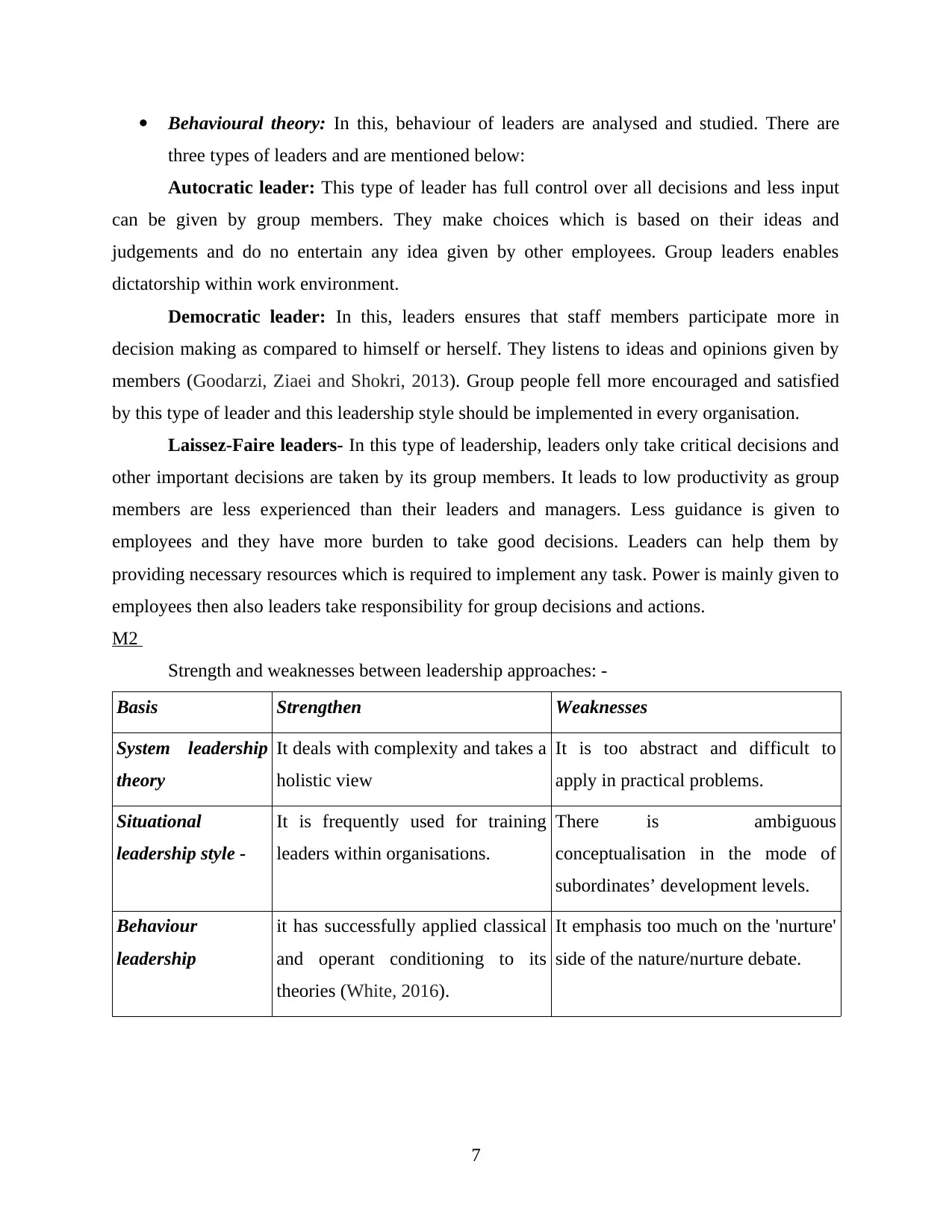
Behavioural theory: In this, behaviour of leaders are analysed and studied. There are
three types of leaders and are mentioned below:
Autocratic leader: This type of leader has full control over all decisions and less input
can be given by group members. They make choices which is based on their ideas and
judgements and do no entertain any idea given by other employees. Group leaders enables
dictatorship within work environment.
Democratic leader: In this, leaders ensures that staff members participate more in
decision making as compared to himself or herself. They listens to ideas and opinions given by
members (Goodarzi, Ziaei and Shokri, 2013). Group people fell more encouraged and satisfied
by this type of leader and this leadership style should be implemented in every organisation.
Laissez-Faire leaders- In this type of leadership, leaders only take critical decisions and
other important decisions are taken by its group members. It leads to low productivity as group
members are less experienced than their leaders and managers. Less guidance is given to
employees and they have more burden to take good decisions. Leaders can help them by
providing necessary resources which is required to implement any task. Power is mainly given to
employees then also leaders take responsibility for group decisions and actions.
M2
Strength and weaknesses between leadership approaches: -
Basis Strengthen Weaknesses
System leadership
theory
It deals with complexity and takes a
holistic view
It is too abstract and difficult to
apply in practical problems.
Situational
leadership style -
It is frequently used for training
leaders within organisations.
There is ambiguous
conceptualisation in the mode of
subordinates’ development levels.
Behaviour
leadership
it has successfully applied classical
and operant conditioning to its
theories (White, 2016).
It emphasis too much on the 'nurture'
side of the nature/nurture debate.
7
three types of leaders and are mentioned below:
Autocratic leader: This type of leader has full control over all decisions and less input
can be given by group members. They make choices which is based on their ideas and
judgements and do no entertain any idea given by other employees. Group leaders enables
dictatorship within work environment.
Democratic leader: In this, leaders ensures that staff members participate more in
decision making as compared to himself or herself. They listens to ideas and opinions given by
members (Goodarzi, Ziaei and Shokri, 2013). Group people fell more encouraged and satisfied
by this type of leader and this leadership style should be implemented in every organisation.
Laissez-Faire leaders- In this type of leadership, leaders only take critical decisions and
other important decisions are taken by its group members. It leads to low productivity as group
members are less experienced than their leaders and managers. Less guidance is given to
employees and they have more burden to take good decisions. Leaders can help them by
providing necessary resources which is required to implement any task. Power is mainly given to
employees then also leaders take responsibility for group decisions and actions.
M2
Strength and weaknesses between leadership approaches: -
Basis Strengthen Weaknesses
System leadership
theory
It deals with complexity and takes a
holistic view
It is too abstract and difficult to
apply in practical problems.
Situational
leadership style -
It is frequently used for training
leaders within organisations.
There is ambiguous
conceptualisation in the mode of
subordinates’ development levels.
Behaviour
leadership
it has successfully applied classical
and operant conditioning to its
theories (White, 2016).
It emphasis too much on the 'nurture'
side of the nature/nurture debate.
7
⊘ This is a preview!⊘
Do you want full access?
Subscribe today to unlock all pages.

Trusted by 1+ million students worldwide
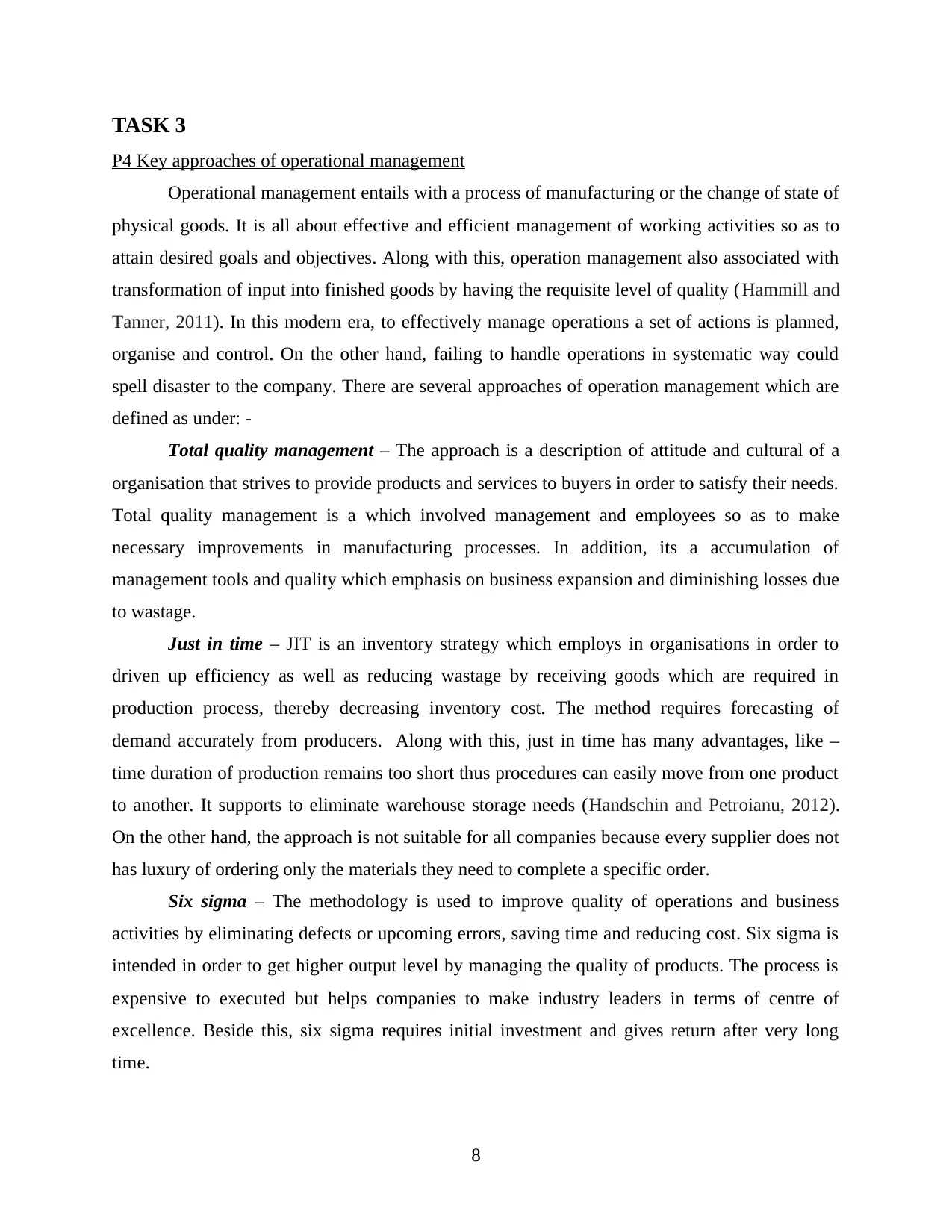
TASK 3
P4 Key approaches of operational management
Operational management entails with a process of manufacturing or the change of state of
physical goods. It is all about effective and efficient management of working activities so as to
attain desired goals and objectives. Along with this, operation management also associated with
transformation of input into finished goods by having the requisite level of quality (Hammill and
Tanner, 2011). In this modern era, to effectively manage operations a set of actions is planned,
organise and control. On the other hand, failing to handle operations in systematic way could
spell disaster to the company. There are several approaches of operation management which are
defined as under: -
Total quality management – The approach is a description of attitude and cultural of a
organisation that strives to provide products and services to buyers in order to satisfy their needs.
Total quality management is a which involved management and employees so as to make
necessary improvements in manufacturing processes. In addition, its a accumulation of
management tools and quality which emphasis on business expansion and diminishing losses due
to wastage.
Just in time – JIT is an inventory strategy which employs in organisations in order to
driven up efficiency as well as reducing wastage by receiving goods which are required in
production process, thereby decreasing inventory cost. The method requires forecasting of
demand accurately from producers. Along with this, just in time has many advantages, like –
time duration of production remains too short thus procedures can easily move from one product
to another. It supports to eliminate warehouse storage needs (Handschin and Petroianu, 2012).
On the other hand, the approach is not suitable for all companies because every supplier does not
has luxury of ordering only the materials they need to complete a specific order.
Six sigma – The methodology is used to improve quality of operations and business
activities by eliminating defects or upcoming errors, saving time and reducing cost. Six sigma is
intended in order to get higher output level by managing the quality of products. The process is
expensive to executed but helps companies to make industry leaders in terms of centre of
excellence. Beside this, six sigma requires initial investment and gives return after very long
time.
8
P4 Key approaches of operational management
Operational management entails with a process of manufacturing or the change of state of
physical goods. It is all about effective and efficient management of working activities so as to
attain desired goals and objectives. Along with this, operation management also associated with
transformation of input into finished goods by having the requisite level of quality (Hammill and
Tanner, 2011). In this modern era, to effectively manage operations a set of actions is planned,
organise and control. On the other hand, failing to handle operations in systematic way could
spell disaster to the company. There are several approaches of operation management which are
defined as under: -
Total quality management – The approach is a description of attitude and cultural of a
organisation that strives to provide products and services to buyers in order to satisfy their needs.
Total quality management is a which involved management and employees so as to make
necessary improvements in manufacturing processes. In addition, its a accumulation of
management tools and quality which emphasis on business expansion and diminishing losses due
to wastage.
Just in time – JIT is an inventory strategy which employs in organisations in order to
driven up efficiency as well as reducing wastage by receiving goods which are required in
production process, thereby decreasing inventory cost. The method requires forecasting of
demand accurately from producers. Along with this, just in time has many advantages, like –
time duration of production remains too short thus procedures can easily move from one product
to another. It supports to eliminate warehouse storage needs (Handschin and Petroianu, 2012).
On the other hand, the approach is not suitable for all companies because every supplier does not
has luxury of ordering only the materials they need to complete a specific order.
Six sigma – The methodology is used to improve quality of operations and business
activities by eliminating defects or upcoming errors, saving time and reducing cost. Six sigma is
intended in order to get higher output level by managing the quality of products. The process is
expensive to executed but helps companies to make industry leaders in terms of centre of
excellence. Beside this, six sigma requires initial investment and gives return after very long
time.
8
Paraphrase This Document
Need a fresh take? Get an instant paraphrase of this document with our AI Paraphraser
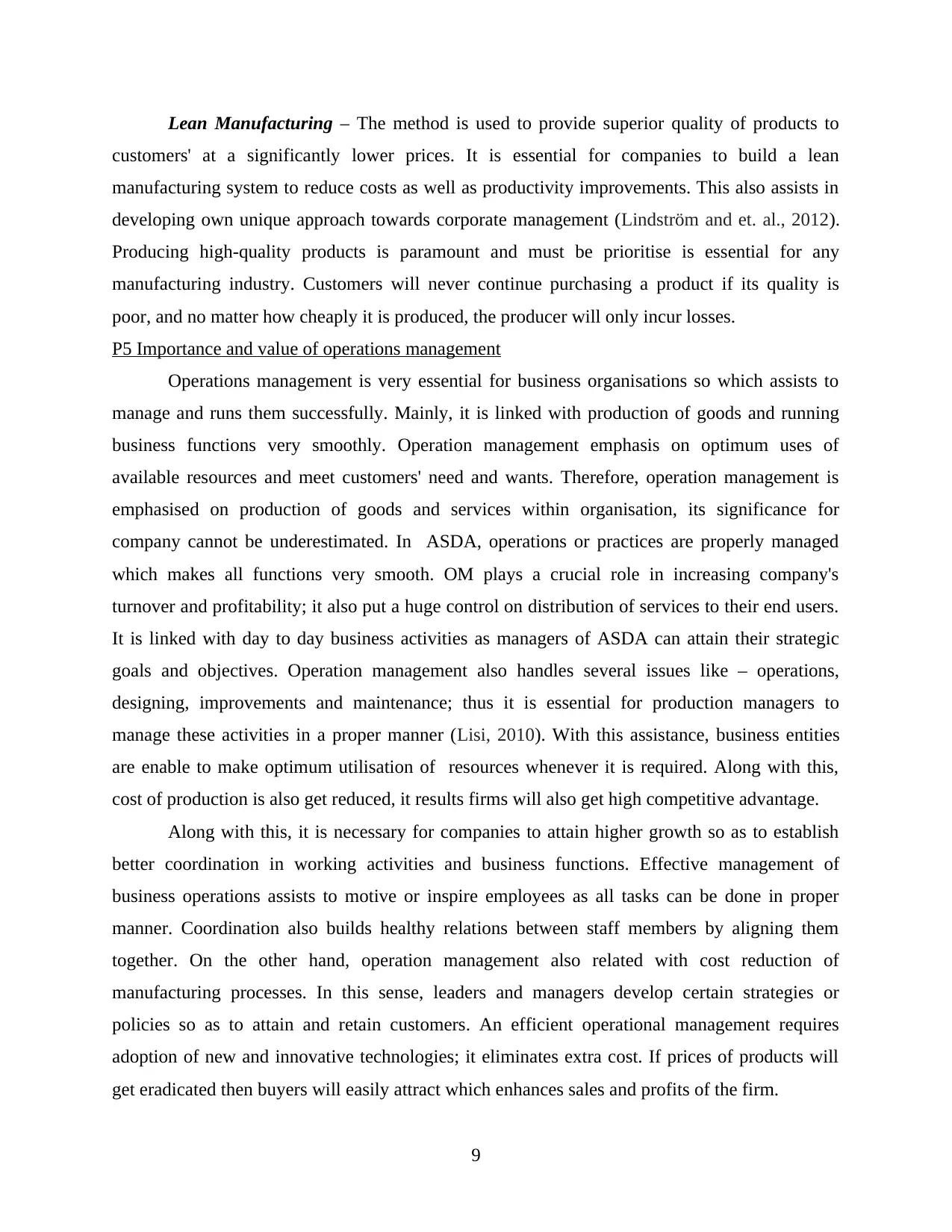
Lean Manufacturing – The method is used to provide superior quality of products to
customers' at a significantly lower prices. It is essential for companies to build a lean
manufacturing system to reduce costs as well as productivity improvements. This also assists in
developing own unique approach towards corporate management (Lindström and et. al., 2012).
Producing high-quality products is paramount and must be prioritise is essential for any
manufacturing industry. Customers will never continue purchasing a product if its quality is
poor, and no matter how cheaply it is produced, the producer will only incur losses.
P5 Importance and value of operations management
Operations management is very essential for business organisations so which assists to
manage and runs them successfully. Mainly, it is linked with production of goods and running
business functions very smoothly. Operation management emphasis on optimum uses of
available resources and meet customers' need and wants. Therefore, operation management is
emphasised on production of goods and services within organisation, its significance for
company cannot be underestimated. In ASDA, operations or practices are properly managed
which makes all functions very smooth. OM plays a crucial role in increasing company's
turnover and profitability; it also put a huge control on distribution of services to their end users.
It is linked with day to day business activities as managers of ASDA can attain their strategic
goals and objectives. Operation management also handles several issues like – operations,
designing, improvements and maintenance; thus it is essential for production managers to
manage these activities in a proper manner (Lisi, 2010). With this assistance, business entities
are enable to make optimum utilisation of resources whenever it is required. Along with this,
cost of production is also get reduced, it results firms will also get high competitive advantage.
Along with this, it is necessary for companies to attain higher growth so as to establish
better coordination in working activities and business functions. Effective management of
business operations assists to motive or inspire employees as all tasks can be done in proper
manner. Coordination also builds healthy relations between staff members by aligning them
together. On the other hand, operation management also related with cost reduction of
manufacturing processes. In this sense, leaders and managers develop certain strategies or
policies so as to attain and retain customers. An efficient operational management requires
adoption of new and innovative technologies; it eliminates extra cost. If prices of products will
get eradicated then buyers will easily attract which enhances sales and profits of the firm.
9
customers' at a significantly lower prices. It is essential for companies to build a lean
manufacturing system to reduce costs as well as productivity improvements. This also assists in
developing own unique approach towards corporate management (Lindström and et. al., 2012).
Producing high-quality products is paramount and must be prioritise is essential for any
manufacturing industry. Customers will never continue purchasing a product if its quality is
poor, and no matter how cheaply it is produced, the producer will only incur losses.
P5 Importance and value of operations management
Operations management is very essential for business organisations so which assists to
manage and runs them successfully. Mainly, it is linked with production of goods and running
business functions very smoothly. Operation management emphasis on optimum uses of
available resources and meet customers' need and wants. Therefore, operation management is
emphasised on production of goods and services within organisation, its significance for
company cannot be underestimated. In ASDA, operations or practices are properly managed
which makes all functions very smooth. OM plays a crucial role in increasing company's
turnover and profitability; it also put a huge control on distribution of services to their end users.
It is linked with day to day business activities as managers of ASDA can attain their strategic
goals and objectives. Operation management also handles several issues like – operations,
designing, improvements and maintenance; thus it is essential for production managers to
manage these activities in a proper manner (Lisi, 2010). With this assistance, business entities
are enable to make optimum utilisation of resources whenever it is required. Along with this,
cost of production is also get reduced, it results firms will also get high competitive advantage.
Along with this, it is necessary for companies to attain higher growth so as to establish
better coordination in working activities and business functions. Effective management of
business operations assists to motive or inspire employees as all tasks can be done in proper
manner. Coordination also builds healthy relations between staff members by aligning them
together. On the other hand, operation management also related with cost reduction of
manufacturing processes. In this sense, leaders and managers develop certain strategies or
policies so as to attain and retain customers. An efficient operational management requires
adoption of new and innovative technologies; it eliminates extra cost. If prices of products will
get eradicated then buyers will easily attract which enhances sales and profits of the firm.
9
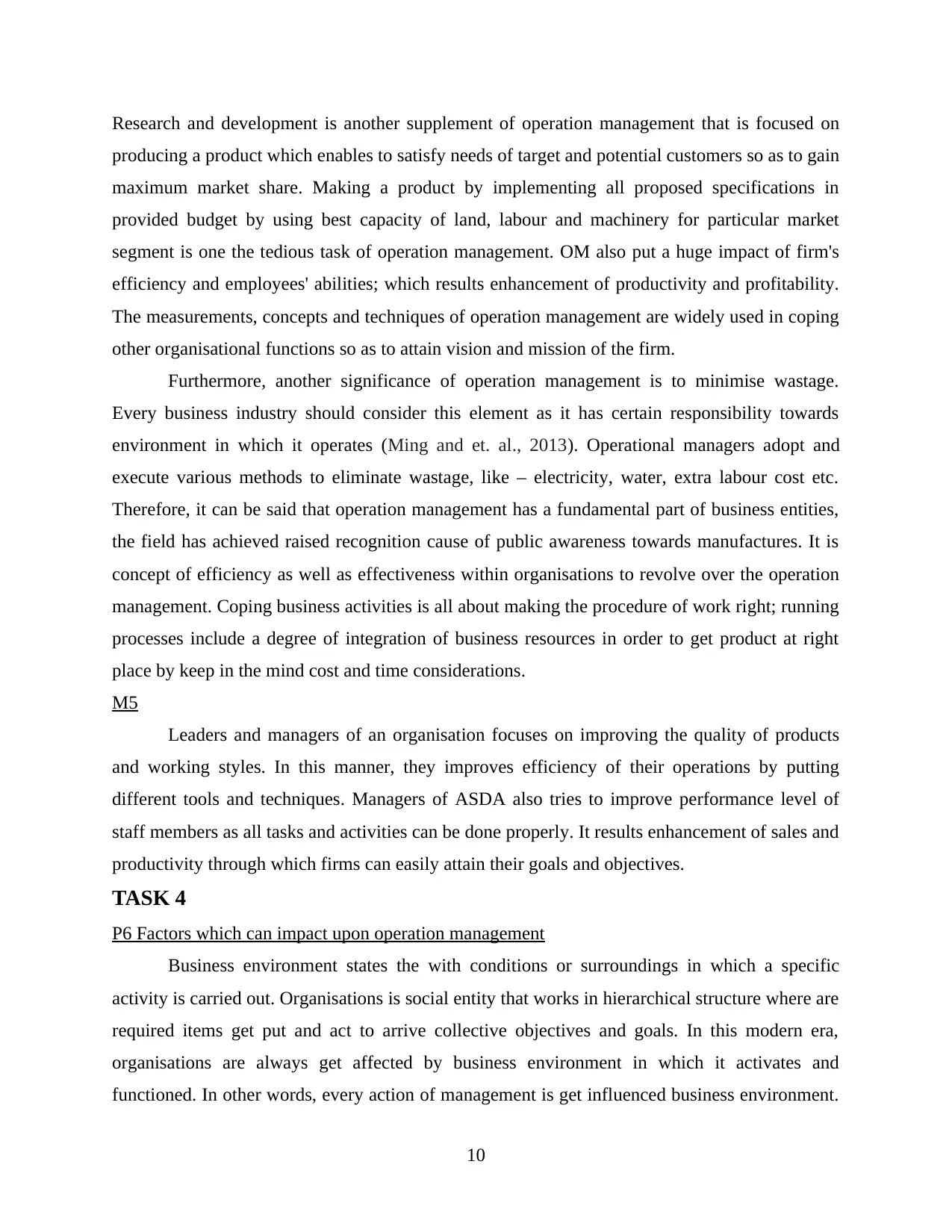
Research and development is another supplement of operation management that is focused on
producing a product which enables to satisfy needs of target and potential customers so as to gain
maximum market share. Making a product by implementing all proposed specifications in
provided budget by using best capacity of land, labour and machinery for particular market
segment is one the tedious task of operation management. OM also put a huge impact of firm's
efficiency and employees' abilities; which results enhancement of productivity and profitability.
The measurements, concepts and techniques of operation management are widely used in coping
other organisational functions so as to attain vision and mission of the firm.
Furthermore, another significance of operation management is to minimise wastage.
Every business industry should consider this element as it has certain responsibility towards
environment in which it operates (Ming and et. al., 2013). Operational managers adopt and
execute various methods to eliminate wastage, like – electricity, water, extra labour cost etc.
Therefore, it can be said that operation management has a fundamental part of business entities,
the field has achieved raised recognition cause of public awareness towards manufactures. It is
concept of efficiency as well as effectiveness within organisations to revolve over the operation
management. Coping business activities is all about making the procedure of work right; running
processes include a degree of integration of business resources in order to get product at right
place by keep in the mind cost and time considerations.
M5
Leaders and managers of an organisation focuses on improving the quality of products
and working styles. In this manner, they improves efficiency of their operations by putting
different tools and techniques. Managers of ASDA also tries to improve performance level of
staff members as all tasks and activities can be done properly. It results enhancement of sales and
productivity through which firms can easily attain their goals and objectives.
TASK 4
P6 Factors which can impact upon operation management
Business environment states the with conditions or surroundings in which a specific
activity is carried out. Organisations is social entity that works in hierarchical structure where are
required items get put and act to arrive collective objectives and goals. In this modern era,
organisations are always get affected by business environment in which it activates and
functioned. In other words, every action of management is get influenced business environment.
10
producing a product which enables to satisfy needs of target and potential customers so as to gain
maximum market share. Making a product by implementing all proposed specifications in
provided budget by using best capacity of land, labour and machinery for particular market
segment is one the tedious task of operation management. OM also put a huge impact of firm's
efficiency and employees' abilities; which results enhancement of productivity and profitability.
The measurements, concepts and techniques of operation management are widely used in coping
other organisational functions so as to attain vision and mission of the firm.
Furthermore, another significance of operation management is to minimise wastage.
Every business industry should consider this element as it has certain responsibility towards
environment in which it operates (Ming and et. al., 2013). Operational managers adopt and
execute various methods to eliminate wastage, like – electricity, water, extra labour cost etc.
Therefore, it can be said that operation management has a fundamental part of business entities,
the field has achieved raised recognition cause of public awareness towards manufactures. It is
concept of efficiency as well as effectiveness within organisations to revolve over the operation
management. Coping business activities is all about making the procedure of work right; running
processes include a degree of integration of business resources in order to get product at right
place by keep in the mind cost and time considerations.
M5
Leaders and managers of an organisation focuses on improving the quality of products
and working styles. In this manner, they improves efficiency of their operations by putting
different tools and techniques. Managers of ASDA also tries to improve performance level of
staff members as all tasks and activities can be done properly. It results enhancement of sales and
productivity through which firms can easily attain their goals and objectives.
TASK 4
P6 Factors which can impact upon operation management
Business environment states the with conditions or surroundings in which a specific
activity is carried out. Organisations is social entity that works in hierarchical structure where are
required items get put and act to arrive collective objectives and goals. In this modern era,
organisations are always get affected by business environment in which it activates and
functioned. In other words, every action of management is get influenced business environment.
10
⊘ This is a preview!⊘
Do you want full access?
Subscribe today to unlock all pages.

Trusted by 1+ million students worldwide
1 out of 17
Related Documents
Your All-in-One AI-Powered Toolkit for Academic Success.
+13062052269
info@desklib.com
Available 24*7 on WhatsApp / Email
![[object Object]](/_next/static/media/star-bottom.7253800d.svg)
Unlock your academic potential
Copyright © 2020–2025 A2Z Services. All Rights Reserved. Developed and managed by ZUCOL.





